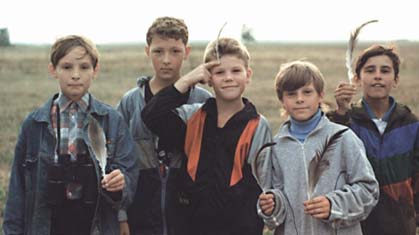A special spiritual link between humans and nature in the Homeland of
the Crane can be traced back to the beginning of time.
The Dubna valley is a priceless source of archaeological information about
the Stone-Age hunting and fishing tribes who settled here around 10,000
years ago. Scientists from the Institute of Archaeology have  found the world's oldest corduroy road -a wooden causeway across a bog, built
around 7,500 years ago. The frequent discoveries of images of birds and
beasts bear witness to the deep-rooted spiritual link between the ancient
people and nature. Bone figurines of birds from the Zamostye-2 site that
have been analysed by scientists from the Sergiev Posad Reserve-Museum
are 7,400 years old. It is possible that the shaman of an ancient tribe
wore them as part of his clothing during a kamlaniye [seance], with the
birds helping him ascend to the sky and communicate with the spirits.
found the world's oldest corduroy road -a wooden causeway across a bog, built
around 7,500 years ago. The frequent discoveries of images of birds and
beasts bear witness to the deep-rooted spiritual link between the ancient
people and nature. Bone figurines of birds from the Zamostye-2 site that
have been analysed by scientists from the Sergiev Posad Reserve-Museum
are 7,400 years old. It is possible that the shaman of an ancient tribe
wore them as part of his clothing during a kamlaniye [seance], with the
birds helping him ascend to the sky and communicate with the spirits.
Even now, people respect the birds, especially the cranes. Old-timers
will tell you that the crane is a divine bird. That cranes live in pairs
- husband and wife - and that if the one dies, the other 'pines away'
with grief. Hunting cranes has here been since ancient times considered
a sin that brings misfortune on the killer's village and relatives. When
saying goodbye to the cranes in the autumn, people would call out after
them, wishing them a safe journey and return: 'A journey is like a wheel!
Farewell, dear mothers; we'll meet again!'
The traditional ecological culture of the local residents had not yet
been completely crushed under the onslaught of modern civilisation when,
at the end of the 1920s, Mikhail Privshin took up residence in the area
around Lake Zabolotskoye to write a novel about an engineer called Allatov
who was supposed to drainabog lake and open up 'A Golden Meadow' for the
people. But the longer Privshin lived near the bogs, theless he liked
the idea of exploiting and destroying them. The planned novel did not
pan out. Instead he wrote a story about the crane's precious bogs - The
Homeland of the Crane, which was to give its name to the area as a whole.
Even today, that link remains unbroken. Every autumn the Crane Festival,
run by the Homeland of the Crane Ecological and Educational Centre, brings
together children from Taldom and Sergiev Posad districts. The children
go bird-watching and learn about the wildlife of their native bogs. The
Taldom Museum of History and Literature, in collaboration with the EcoCentre,
has set up a Museum of the Crane. It is located on farmland where the
poet Sergey Klychkov once lived, in the village of Dubrovka. A group called
"Veresen" [from the Old Slavonic word for 'September' -A. G.],
from the Taldom College of Arts, performs at ecological festivals and
conferences, and young artists from the college design information panels
for wildlife sanctuaries. Schoolchildren from the village of Koshelevo
organise drives to clean up and improve the condition of the protected
natural areas.


